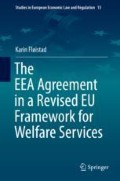Abstract
This chapter sums up the main findings on the EEA integration process in the field of publicly funded welfare services tying the three parts of study together. The chapter first introduces the delimitation of the project limited to EU primary law changes and focuses on how the viability of the EU project came to depend on not separating the market integration from socially oriented objectives. Second, the chapter points to the particular concerns in the EEA dimension when the revised EU legal framework gave new powers to the EU institutions. Furthermore, it is explained how the study has not only revealed consequences for EFTA States but also for EU Member States giving a new dimension to the legal effect of the principles of dynamism and homogeneity and indeed to the EEA integration process itself.
The overall findings and observations are then explained separating between (1) the sequences of events and (2) identified legal techniques before the final section reflecting on implications for future research.
On the sequence of events the importance of beginning the development with the free movement of health care services and the early ‘citizenship’ case law is identified. Furthermore, it is pointed to the importance of initial development on state aid and public services to be directed towards protecting such services. It is only more recently that the revised constitutional framework for public services has been identified to also lead to an increased political and legislative role for EU/EFTA institution.
On the identified legal techniques the observations distinguish between two categories; The least controversial is when the EU/EFTA institutions apply indirectly the revised constitutional framework of the EU in an interpretation process of already-existing provisions in the EEA. More controversial is a more recent technique necessary in situations where the CJEU develop rights relying exclusively or mainly on primary law provision snot paralleled in the EEA. It is argued that in all the three areas of welfare services studied this last situation has occurred. This brings the project to the conclusion that the institutions have consistently opted for a legal outcome of achieving the same end result in the EEA as in the EU legal order even without a parallel legal framework.
The project is limited to legal aspects and does not take a normative stance on the way the European integration process has developed. The author is more concerned with the demonstrated consequences of these institutional choices—in particular in a sensitive and highly policy oriented domain as the welfare sector. The urgent need for better transparency is a recurring theme leading to the inevitable request for further action on the part of the Contracting Parties to the EEA Agreement.
Access this chapter
Tax calculation will be finalised at checkout
Purchases are for personal use only
Notes
- 1.
Case E-15/12 Wahl, paragraph 75.
- 2.
See the Norwegian Government’s submission in Case E-1/02 referring to the revised primary law provision on equality of sexes and the Icelandic Government’s submission in Case E-12/10 referring to several provisions in the Charter of Fundamental Rights.
- 3.
Both the Icelandic and the Norwegian submissions in Case E-26/13 and the Norwegian Government’s submission in Cases E-10/14 and E-28/15.
- 4.
Case C-341/11 UK v Council, EU:C:2013:589.
- 5.
This includes all the relevant cases analyse in the EFTA Court and the Case C-341/11 UK v Council, EU:C:2013:589 in the CJEU.
- 6.
An example would be the application of the state aid provisions by the Commission.
- 7.
An example would be the CJEU’s application of the citizenship provisions in the Treaty.
- 8.
- 9.
See written observations from the Commission and the Surveillance Authority and the Report for the Hearing.
- 10.
See Cases C-333/13 Dano EU:C:2014:2358 and C-67/14 Alimanovic EU:C:2015:5 and C-308/14, Commission v. UK and Ireland decided 14 June 2016, EU:C:2016:436.
- 11.
See the earlier referred articles in CML Rev (52) 2015.
- 12.
Fredriksen and Franklin (2015), pp. 629–684.
References
Bjørgvinsson DT (2014) EFTA Court, The EEA and the EFTA Court, chapter 22, Fundamental Rights in EEA Law, pp 263–280
Fredriksen HH (2013) Betydningen av EUs pakt om grunnleggende rettigheter for EØS-retten. Jussens Venner 48:371–399
Fredriksen HH, Franklin CNK (2015) Of pragmatism and principles: the EEA Agreement 20 years on. Common Mark Law Rev 52:629–684
Author information
Authors and Affiliations
Rights and permissions
Copyright information
© 2018 Springer International Publishing AG, part of Springer Nature
About this chapter
Cite this chapter
Fløistad, K. (2018). Final Observations: Concluding Remarks. In: The EEA Agreement in a Revised EU Framework for Welfare Services. Studies in European Economic Law and Regulation, vol 13. Springer, Cham. https://doi.org/10.1007/978-3-319-95043-3_15
Download citation
DOI: https://doi.org/10.1007/978-3-319-95043-3_15
Published:
Publisher Name: Springer, Cham
Print ISBN: 978-3-319-95042-6
Online ISBN: 978-3-319-95043-3
eBook Packages: Law and CriminologyLaw and Criminology (R0)

